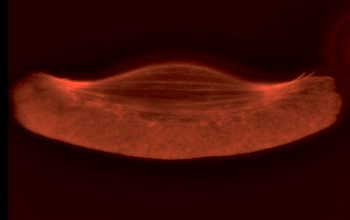All Images
News Release 05-216
Modified Microscope Proves Critical to Uncovering Cell-growth Secret
Tiny cantilevers track movements of cell scaffolding
This material is available primarily for archival purposes. Telephone numbers or other contact information may be out of date; please see current contact information at media contacts.

A window into the cell reveals the actin network and organelles inside a macrophage as it pursues bacterial invaders. Actin forms long filaments that lie just beneath the surface of the cell, giving it structure and stability. As the immune cell crawls and looks for invaders, such as the bacterium E. coli, new actin growth helps to push the cell forward. Researchers used an atomic force microscope (AFM) to study aspects of actin growth.
Credit: Nicolle Rager Fuller, National Science Foundation
Download the high-resolution JPG version of the image. (482 KB)
Use your mouse to right-click (Mac users may need to Ctrl-click) the link above and choose the option that will save the file or target to your computer.

Actin in this fish cell is stained with a red fluorescent dye. The bright areas on the top edge depict growing actin networks.
Credit: University of California, Berkeley
Download the high-resolution JPG version of the image. (17 KB)
Use your mouse to right-click (Mac users may need to Ctrl-click) the link above and choose the option that will save the file or target to your computer.


